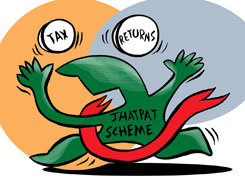IT Professional (27) Asks: Which Tax Regime is Best for 2024-25?
Ramalingam Kalirajan |10872 Answers |Ask -Follow
Mutual Funds, Financial Planning Expert - Answered on Jul 31, 2024
He has an MBA in finance from the University of Madras and is a certified financial planner.
He is the director and chief financial planner at Holistic Investment, a Chennai-based firm that offers financial planning and wealth management advice.... more

I'm 27. Working in IT sector with annual package of 26L. Which tax regime if beneficial? Considering changes made in latest budget2024. I have following investments. PPF, SSY, NPS, thinking to opt for Corporate NPS option too.
Current Financial Situation
Age: 27 years
Profession: IT sector
Annual Income: Rs. 26 lakhs
Investments: PPF, SSY, NPS
Considering: Corporate NPS
Understanding Tax Regimes
1. Old Tax Regime
Deductions: Offers various deductions like 80C, 80D, and more.
Exemptions: Includes HRA, LTA, and others.
2. New Tax Regime
Lower Rates: Provides lower tax rates but no deductions or exemptions.
Simplified: Easier for those with fewer investments.
Analyzing Your Investments
1. Public Provident Fund (PPF)
Benefits: Tax deduction under Section 80C. Tax-free interest.
Long-Term: Great for long-term wealth accumulation.
2. Sukanya Samriddhi Yojana (SSY)
Benefits: Tax deduction under Section 80C. Tax-free returns.
Goal-Oriented: Ideal for securing your daughter’s future.
3. National Pension System (NPS)
Benefits: Additional deduction under Section 80CCD(1B). Partial tax-free withdrawals.
Retirement Planning: Helps in building a retirement corpus.
Benefits of Corporate NPS
Employer Contribution: Additional tax benefits if your employer contributes.
Flexibility: Offers flexibility in choosing investment options.
Tax Regime Decision
1. Calculate Deductions
Old Regime: Calculate total deductions including 80C, 80D, and others.
Compare: Check if total deductions significantly reduce your taxable income.
2. Evaluate New Regime
Flat Rates: Compare the tax payable under the new regime with lower rates.
Simplicity: Easier filing if you don't need deductions.
Recommended Approach
1. Use Old Tax Regime
For Maximizing Deductions: If total deductions and exemptions significantly lower your taxable income.
2. Switch to New Regime
If Simplified: If deductions are minimal and you prefer simpler filing.
Steps to Optimize Tax Savings
1. Maximize 80C Limit
Invest Fully: Ensure PPF, SSY, and NPS contributions utilize the Rs. 1.5 lakh limit.
2. Additional NPS Benefit
Section 80CCD(1B): Invest an additional Rs. 50,000 in NPS for extra tax benefits.
3. Health Insurance
Section 80D: Get health insurance for additional tax deductions.
Future Investments
1. Diversify
Mutual Funds: Consider SIPs in equity mutual funds for long-term growth.
Avoid Real Estate: Focus on financial assets for better liquidity and returns.
2. Emergency Fund
Build Savings: Set aside at least 6 months’ expenses in a liquid fund.
3. Regular Review
Annual Check: Review your investments and tax-saving strategies every year.
Final Insights
Choosing the right tax regime depends on your investment profile. If you have significant deductions, the old regime is beneficial. If simplicity and lower rates appeal to you, consider the new regime. Keep investing in PPF, SSY, and NPS for long-term growth and tax benefits.
Best Regards,
K. Ramalingam, MBA, CFP,
Chief Financial Planner,
www.holisticinvestment.in
You may like to see similar questions and answers below
Mihir Tanna |1090 Answers |Ask -Follow
Tax Expert - Answered on Feb 23, 2023
Vivek Lala |323 Answers |Ask -Follow
Tax, MF Expert - Answered on Mar 20, 2023
Hardik Parikh | Answer |Ask -Follow
Tax, Mutual Fund Expert - Answered on Apr 11, 2023
Ramalingam Kalirajan |10872 Answers |Ask -Follow
Mutual Funds, Financial Planning Expert - Answered on Aug 14, 2024
Radheshyam Zanwar |6736 Answers |Ask -Follow
MHT-CET, IIT-JEE, NEET-UG Expert - Answered on Dec 06, 2025

Good luck.
Follow me if you receive this reply.
Radheshyam
Dr Nagarajan J S K |2576 Answers |Ask -Follow
NEET, Medical, Pharmacy Careers - Answered on Dec 06, 2025
Mihir Tanna |1090 Answers |Ask -Follow
Tax Expert - Answered on Dec 06, 2025
Ramalingam Kalirajan |10872 Answers |Ask -Follow
Mutual Funds, Financial Planning Expert - Answered on Dec 06, 2025
Radheshyam Zanwar |6736 Answers |Ask -Follow
MHT-CET, IIT-JEE, NEET-UG Expert - Answered on Dec 06, 2025
Radheshyam Zanwar |6736 Answers |Ask -Follow
MHT-CET, IIT-JEE, NEET-UG Expert - Answered on Dec 06, 2025
Radheshyam Zanwar |6736 Answers |Ask -Follow
MHT-CET, IIT-JEE, NEET-UG Expert - Answered on Dec 06, 2025
Dr Dipankar Dutta |1837 Answers |Ask -Follow
Tech Careers and Skill Development Expert - Answered on Dec 05, 2025
Dr Shyam Jamalabad |108 Answers |Ask -Follow
Dentist - Answered on Dec 05, 2025
Dr Shyam Jamalabad |108 Answers |Ask -Follow
Dentist - Answered on Dec 05, 2025

























